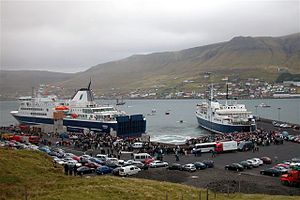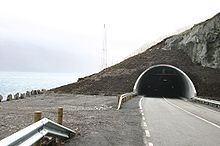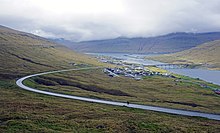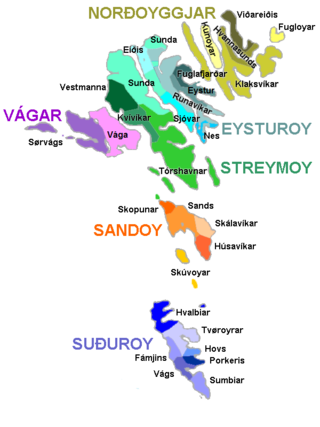
The Faroe Islands are divided into 29 municipalities, six regions/shires and since 2007 there has been only one constituency, earlier there were seven constituencies. Each region has one sheriff.

Vágar Airport is the only airport in the Faroe Islands, and is located 1 NM east of the village of Sørvágur, on the island of Vágar. Due to the Faroe Islands' status as a self-governing territory, the airport is not subject to the rules of the European Union. It is the main operating base for Faroese national airline Atlantic Airways and, for a brief period during 2006, was also the base for the low-cost airline FaroeJet.

Klaksvík is the second largest town of the Faroe Islands behind Tórshavn. The town is located on Borðoy, which is one of the northernmost islands. It is the administrative centre of Klaksvík municipality.

Suðuroy is the southernmost of the Faroe Islands. The island covers 163.7 square kilometres (63.2 sq mi). In 2018 the population was 4,601. Suðuroy region (sýsla) comprises this island and Lítla Dímun, the next isle northward in the Faroes, which is uninhabited.

Streymoy is the largest and most populated island of the Faroe Islands. The capital, Tórshavn, is located on its southeast coast. The name means "island of currents". It also refers to the largest region of the country that also includes the islands of Hestur, Koltur and Nólsoy.

Eysturoy is a region and the second-largest of the Faroe Islands, both in size and population.
Atlantic Airways is the national airline of the Faroe Islands, operating domestic helicopter services and international passenger services as well as search and rescue responsibilities from its base at Vágar Airport, on the Faroese island of Vágar. Most of its pilots are members of the Faroese Pilot Association. Its 2021 revenue was 410.2mm DKK.

The Smyril is a passenger and car ferry owned and operated by the Faroese transport company Strandfaraskip Landsins. She is the largest ferry in the fleet and the fifth vessel to carry the name Smyril, which is the Faroese word for merlin. The ferry takes 200 cars and 975 passengers.

Strandfaraskip Landsins is the government agency for public transport in the Faroe Islands. It is owned by the Faroese national government under the Ministry of Finance (Fíggjamálaráðið) and runs eight ferry routes and a number of bus routes.

Sunda is a municipality in the Faroe Islands, loosely centered around the Sundini sound between the islands of Streymoy and Eysturoy.

The Eysturoyartunnilin is a large undersea road tunnel under the Tangafjørður sound in the Faroe Islands, connecting the island of Streymoy to the island of Eysturoy. It also crosses the southern part of Skálafjørður, and connects the towns of Runavík on the eastern side and Strendur on the western side of the fjord, and includes the world's first undersea roundabout in the middle of the network.

Sandoyartunnilin is an undersea road tunnel under construction in the Faroe Islands. It will connect the main island of Streymoy with Sandoy to the south. The length of the tunnel will be 10.8 kilometres. The estimated cost is 860 million DKK. The tunnel is expected to be ready for traffic in late 2023, after which the ferry Teistin will cease its route between Gamlarætt on Streymoy and Skopun on Sandoy. The tunnel crosses the Skopunarfjørður and runs from Gamlarætt to Traðardalur in central Sandoy, near the Inni í Dal stadium.

The Streymin Bridge, is an important highway bridge in the Faroe Islands. It connects the two biggest and most populous islands of Streymoy to the west and Eysturoy to the east. Crossing the Sundini sound at its narrowest point, it is jokingly referred to as the 'Bridge over the Atlantic', being the only inter-island bridge in the Faroe Islands, and one of the few such bridges in the Atlantic Ocean.
The Suðuroyartunnilin is a proposed submerged fixed-link in the Faroe Islands, linking the island of Suðuroy to Sandoy. As of 2023, all vehicles and cargo, and virtually all passenger traffic must use the ferry service.

Sundini is the northern section of the sound separating the islands of Streymoy and Eysturoy in the Faroe Islands. The southern section of the strait is named Tangafjørður.

Skopunarfjørður is a strait separating Sandoy and Streymoy in the Faroe Islands. The strait also passes the isle of Hestur.
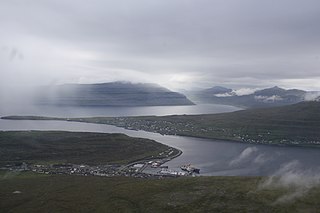
The Faroe Islands consist of 18 islands, several of which are deeply incised by fjords.

Gamlarætt is a ferry port in the Faroe Islands. It is situated on the southwestern side of the island of Streymoy, the largest island in the Faroes, between the villages of Velbastaður and Kirkjubøur. It accommodates ferry services to the islands of Sandoy and Hestur. The port is also used for local salmon farms.
